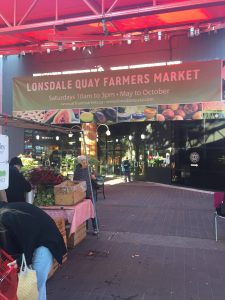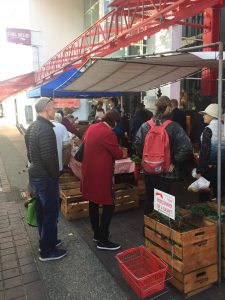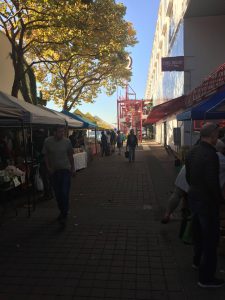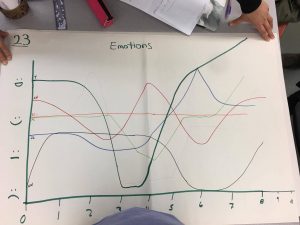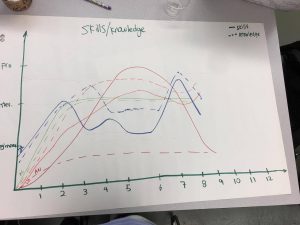What, So What, Now What? – Reflecting on our last moments and wrapping up…
WHAT
Throughout our time in LFS 350 and working the the North Shore Artisan Farmers’ Markets, we experienced many ups downs, many challenges, many “Why are we doing this” conversations, and frequent uncertainty. It was a long journey to the finish line, but now that we are nearing it, we are experiencing our first moments of victory and evidence of the success of our work up to this point.
During this journey, the most important aspect of our project was the methods we used for data collection. We first transferred 10 years of hardcopy vendor data from all three Artisan Markets into an electronic database where it was organized by location, name and type of sellers. This was an incredibly tedious process, but ended up serving us later and contributed to our final victory moment.
Before creating the survey questions we made an initial trip to both Lonsdale and Ambleside Markets to understand context of the environments of our future survey participants. From there, we developed draft survey questions, had them approved by our community partner, made appropriate changes, and finalized our surveys. We traveled to both markets and collected more in-person surveys than we intended, but still felt like we wanted to collect more data. We decided to contact other vendors that were not present when we visited the markets via email. Collectively, we were able to formulate an online survey through UBC’s platform to replicate a physical copy that we had handed out at the farmer’s markets. In total we received more than 60 survey responses in total and completely blew our original goals out of the water!
SO WHAT?
Data analysis was definitely something that was a moment of significance for the group research project. All of our activities in data collection over the past month required everyone to collaborate. We had piles of data. What kind of analysis could we do? What conclusions could we make from this data? What tools did we need? How could we organize it? It was daunting and scary to look at
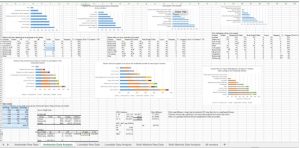
Those were the questions that were running through our heads. We had a variety of data that needed to be analyzed computationally and it was entirely up to us. The prospect of success in the early stages was daunting. Luckily Ayra, had a pretty solid understanding of statistical analysis and ANOVA. She had previous experience with handling data and running statistical analysis on numbers just like these. This was a big turn for the project as these were analysis tools that could give us results and conclusions that would actually be realistic and relevant for our community partner. The milestone was definitely finally getting a real understanding of the data we collected.
As Ayra was running some analysis, we began to notice important patterns. For example, farmers were doing the best financially than any other type of vendor and the longer the farmers sold at a market, the more money they tended to earn daily. It was exciting to see as we were already thinking about what to include into our report and what conclusions we could make for our presentations and infographic.
All in all, we were able to collect data from vendors, compile it, and analyze it to understand the attitudes of farmers and what their motivations are. As we are beginning to see some patterns and conclusions, we are starting to pick out what what we believe is most important for our final report. Tara was able to help us significantly with the data analysis and she was very interested in the patterns that we were discovering together. It was one the project’s deliverables to collect more data that could be useful for Tara. We were lucky enough to have Ayra and Tara work together to make something of the numbers that we had collected, and she loved the data.
Now What
With the results in, we are excited to see what we can do with the data. It is exciting that we can already make some conclusions from what we have.
Although we will be including all of our findings in our final report to our community partner, we need to choose which items are most important for our infographic and presentation next week.
For example
- 57% of vendors say the type of customers in this market are what they enjoy most
- 73% of vendors say that the market location are what they enjoy most
- 33% of vendors say that the change in market location is the most challenging aspect in selling at the market
- 27% of vendors say that the amount of sales made is the most challenging aspect when selling at the market
We are now moving forward with transferring our data and conclusions onto both an infographic presentation and final report. We never would have been able to come to these conclusions the way we have without all of the little victories that lead to our eureka moment with our data. From this results, we are slowly beginning to come up with implications. Why are these numbers important? What can we do to change these numbers? Now, as a group, we are deciding what our recommendations are for the market as the ultimate goal is to have a market structure that integrates the needs of vendors, consumers and the community. For ambleside, our data suggest the location of the market has been an issue therefore our recommendation is to increase marketing and accessibility to the new location in Ambleside. As for Lonsdale, increase consumer participation for increased profit is needed. Our recommendation is to increase an incentive for consumers to participate which can include coupons and community events. Now, this research is not yet complete. The class of LFS 350 2018 aims to support the ultimate goal of vendor and consumer participation. Future research will give us a better understanding on implications to make both parties happy.
It has been a great semester being involved in this community research, and we can’t wait to see the impact we have on this market! We all had a great time with this project, and it was blessing to be working with great group mates as well as an engaging community partner. Big thanks our TA Willson Mendez, Will Valley, and the teaching team for being by our side and giving us support when needed. Along with the further research to be conducted in the future, we can see big a big future for market improvement!
